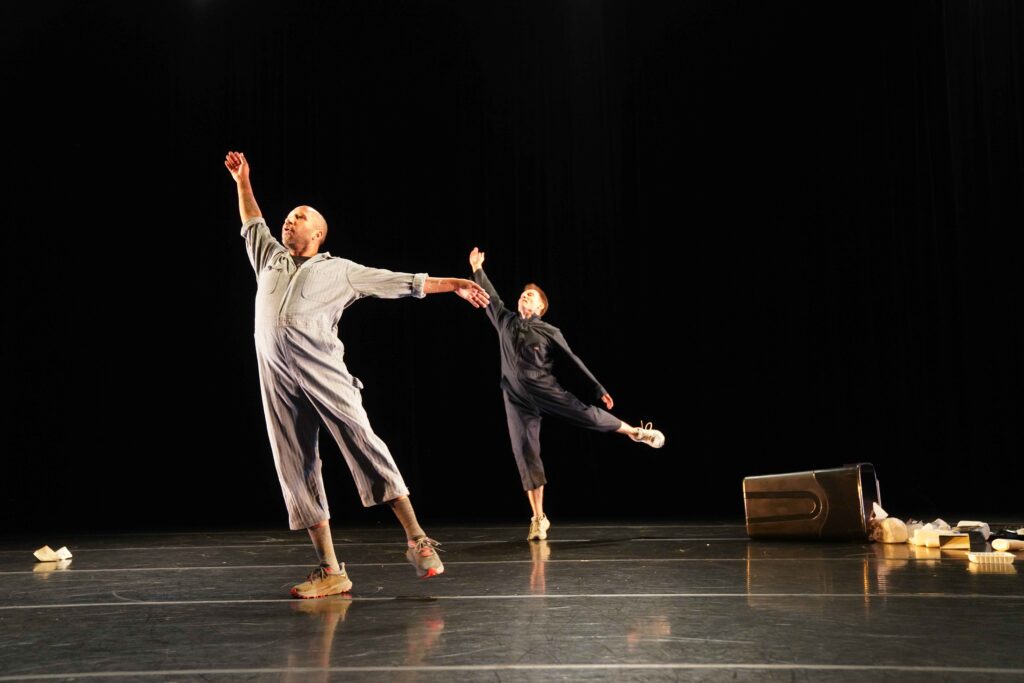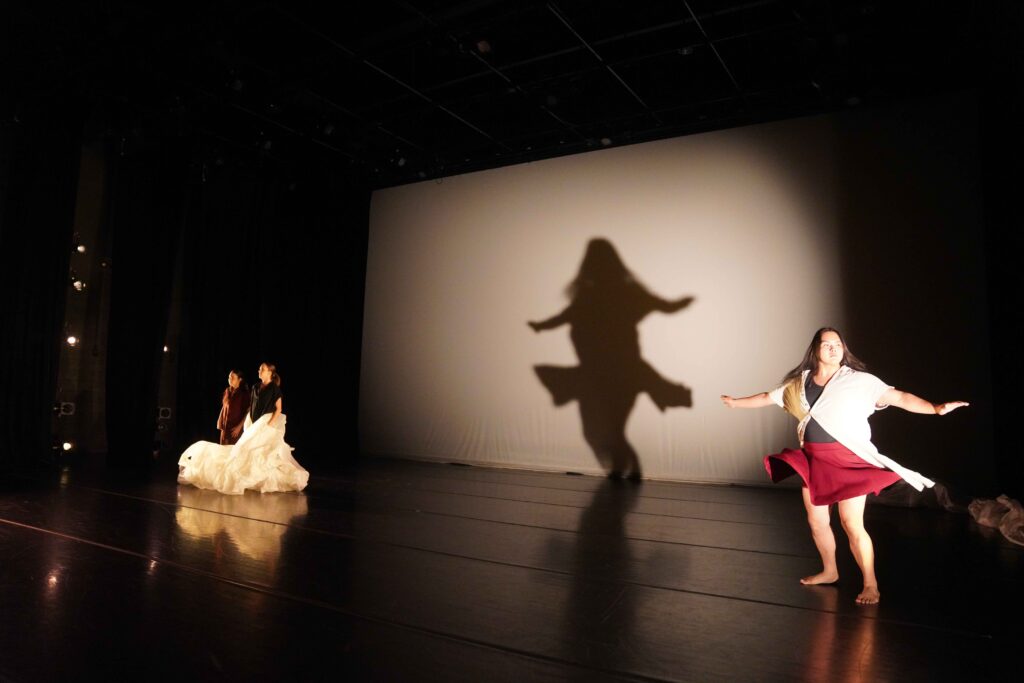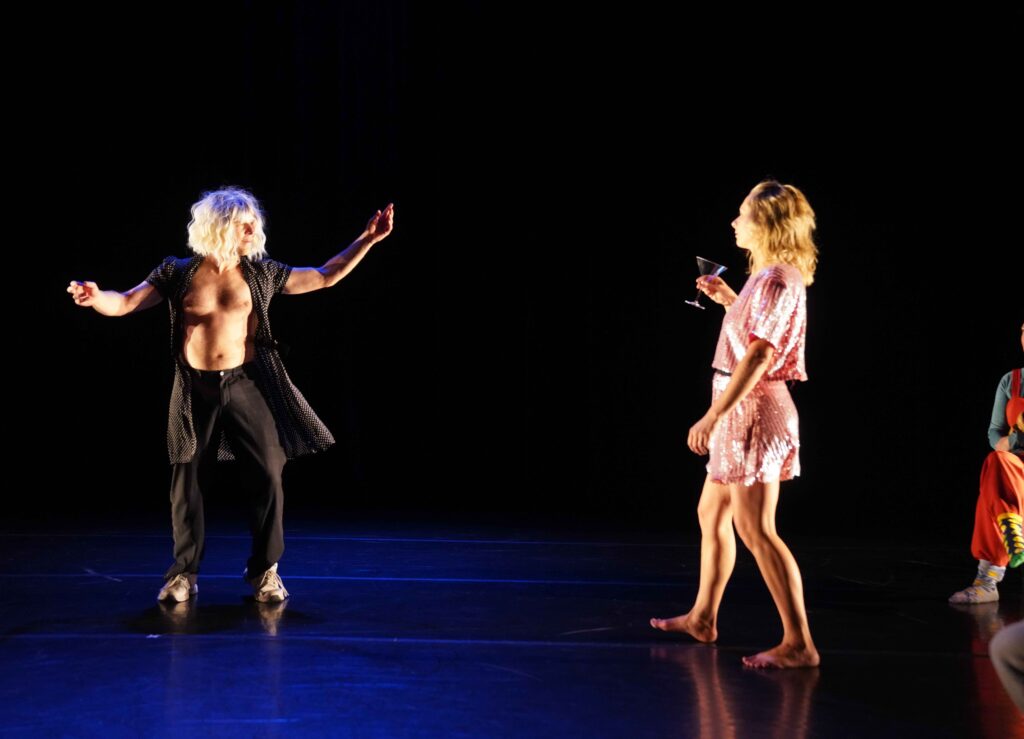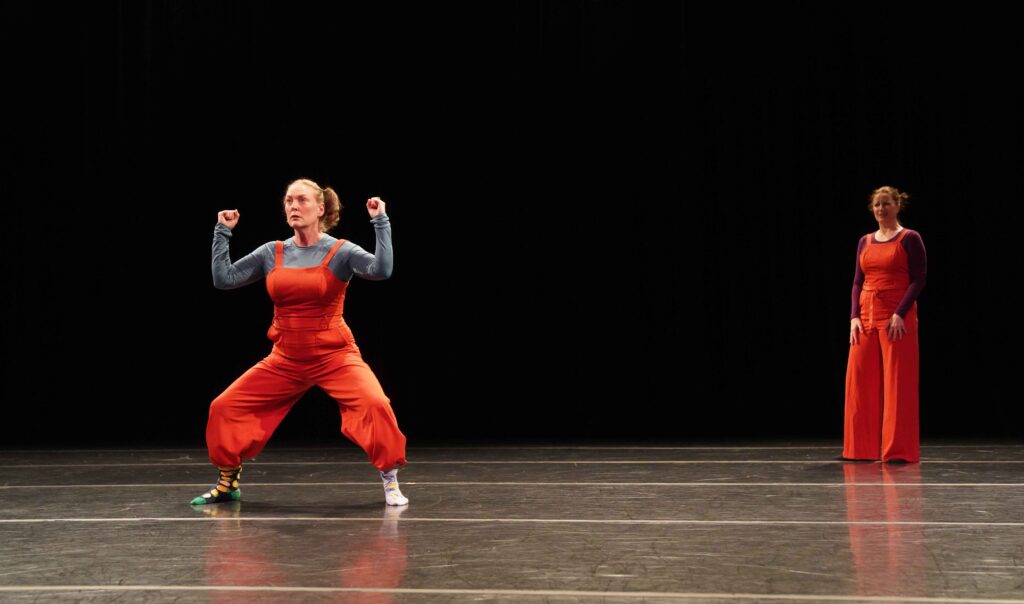TWOFOLD: REPERTORY DANCE THEATRE LINK SERIES
In an internationally recognized hub of modern and contemporary dance such as Salt Lake City, nearly every week brings a show that reflects just how high the bar of excellence is pitched when it comes to movement. As part of Repertory Dance Theatre’s Link Series offerings, always worth checking out, a collection of nine short pieces for Twofold featuring choreographers Meghan Durham Wall, Dmitri Peskov and Lehua Estrada put the emphasis on dance as a paragon of effective collaboration.
Opening the show was Wall’s premiere of We are dead stars, a concept piece accompanied by a thematically spot-on sound score. Wall worked closely with jo Blake and Peskov who performed and improved the work based on Wall’s movement score.
The actual staging is a quotidian scene: two garbage collectors picking up litter and doing so in no rush to complete the task. Both dancers communicate and respond to each other in movement. Wall’s concept is sly in its subtlety. There is a kernel of scientific truth to the assertion that humans are made of stardust, which came from the universe’s earliest times. Wall’s delightfully edited sound score, along with a variety of video imagery, added the right context. These elements include, among other components, content from the European Southern Observatory, NASA recordings and a musical excerpt from her husband Michael Wall, an internationally known composer who collaborates extensively with dance. At a time when the entire world is locked into a mode of existential fear and dread, the opening work encourages us to stay resilient.
Wall elegantly offers a related tangent to the first work with Werklyfe (2024), which she performed as a solo artistic commentary that we should persevere to ensure the domains of our unique capacities for our creativity and consciousness are not subjugated to embodied intelligence technology. The sound score interlaces music by French pop and soul singer and electronic music producer Oner Zeynel, along with snippets by tech journalist Victoria Turk, VeggieTales and World One Tube which offers an interactive platform for creating educational animation pieces.
Wall rounded out her contemporary choreographic social commentary with the premiere of Confessional, which she collaborated on and performed with Lehua Estrada, Eileen Rojas, and Corinne Penka. It was a stirring contemplation of the importance of activism, with a hat tip to the legacy of writer and activist bell hooks whose writings inspired that no one should fear the challenge of realizing their inner yearnings for meaningful change and emancipation.
Meanwhile, Peskov’s The Dying of the Light (2025) is anchored thematically in Dylan Thomas’ iconic villanelle Do Not Go Gentle into That Good Night. Accompanied by Arvo Pärt’s The Deer Cry, and featuring nine dancers, it was an astute choreographic reflection on the value of never accepting the inevitabilities of the evils that currently plague our world.
A premiere of an excerpt of The Alex (Dmitri?) Show, a collaborative work by Peskov and Alexandra Bradshaw-Yerby was humorous in its intentional awkwardness. The work popped in its contrasts, with Bradshaw-Yerby in her textbook-perfect display of dance technique, accompanied by an old school minuet composed by 20th century Russian composer Alfred Schnittke and Peskov’s arrival on stage carrying a purple plastic martini glass. Peskov follows this with his own self-deprecating Jungian account of his various personae.
The second half of Twofold was just as tightly integrated in conceptual themes. After intermission, Lehua Estrada’s O-Six (2023) featured a riveting trio — Devin Etcitty, Kylie Lloyd and Samantha Matsukawa — in a convincing interpretation of the inspired story of the Female 06 wolf in Yellowstone National Park. Estrada’s work was an elucidating complement to themes that the first half’s works of her two fellow choreographers rendered.
The standout comedic piece for Twofold followed: frío, frío, frío (2025), a collaboration with Peskov as creative director that feature Wall, who directs the dance program at Westminster University, with her colleague, Stephanie Stroud, who heads up the school’s theater program. Given this strong performance, we can only hope for a world where professional egos do not always have to clash or become so defensive that a genuine spirit of collaboration becomes impossible to achieve.
The segue between the final two pieces of Twofold was marvelous. The first was the empty home of a heart in trouble (2025), with Peskov, joined by musician and actor Jenn Chandler on cello. Chandler played and spoke, inspired in part by the opening lines of Mark Strand’s poem, Everyday Enchantment of Music (“A rough sound was polished until it became a smoother sound, which was polished until it became music.”). Technique alone does not define the merits or creative potential of an artist. It is to be so emotionally invested that we immerse ourselves individually and collectively in the process of discovering art’s deep, mysterious powers. With that, Twofold closed on Peskov’s wherever we are we are what is missing (2024), featuring seven dancers from the Salt Lake Ballet Cooperative.
INTERMEZZO CHAMBER MUSIC SERIES: SUMMER HIGHLIGHTS
It was an artistically ambitious and successful summer for the Intermezzo Chamber Music Series. The opener, for example, brought the world premiere of a chamber opera by Utah composer Steve Roens and the Utah premiere of a unique compositional blend of Klezmer and Argentinian tango musical sensibilities
Roens’ Look Both Ways, a chamber opera in eight scenes, featured a libretto by distinguished Utah author Katharine Coles, adapted from the first sections of her memoir about her grandparents — geologists Walter Link and Miriam Wollaeger, as chronicled in Look Both Ways, which was published in 2022. The first scene opens in 1923 when Miriam, 16, meets Walter, 22, for the first time and the opera ends on the eve of their marriage in 1929. The opera captures vividly their developing romance and Miriam’s determination to carve out her independence, and her attempt to reconcile these competing forces.
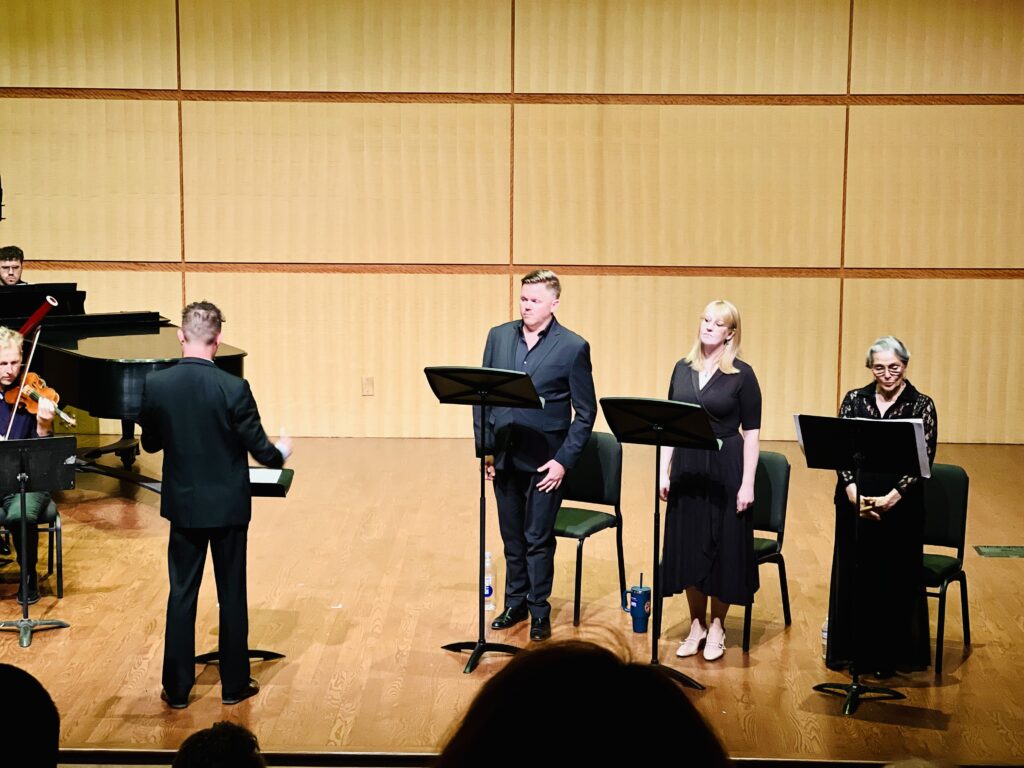
In an interview published elsewhere, Coles explained how she learned about her grandmother’s past. “When I was in college, we corresponded regularly and she began to send me poems she had written as a young woman,” she recalled. “These hinted at a more romantic life than I had suspected. When I visited her, we would go through old photos together and I would get her to label them. It was only much later, when my mother and uncles were clearing out her house and I asked for the letters and journals that I realized how much material there was.” Coles described her grandmother as, “quite brilliant (she spoke five languages fluently, was an accomplished athlete and musician, and was one of the first women to complete a degree in geology at the University of Wisconsin). She was romantic. She was charming and vivacious. And she was full of rage.“
The premiere was near-perfect in execution, with singers Emily Nelson, soprano (Miriam) and Christopher Puckett, tenor (Walter), who were joined by Cheryl Hart, mezzo soprano (portraying Mandy, Miriam’s mother). An eleven-piece orchestra, led by Jared Oaks, provided the right balance, with its complement of woodwinds, brass, piano and strings.
Unlike some American neo-Romantic opera composers who eschewed the Second Viennese School for conservatism that ended up being too static, Roens produced a rich score — simultaneously beautiful, complex and elucidating — that augments the three characters and their voices to generate sonic textures and timbres that are sensitive to Coles’ libretto. In rendering the score, Roens clearly defers to the generous linguistic bounty in Coles’ libretto, particularly in capturing Miriam’s inner conflict of trying to reconcile her strong feelings for Walter while acknowledging her ambitions to define her independence and to set forth her own legacy.
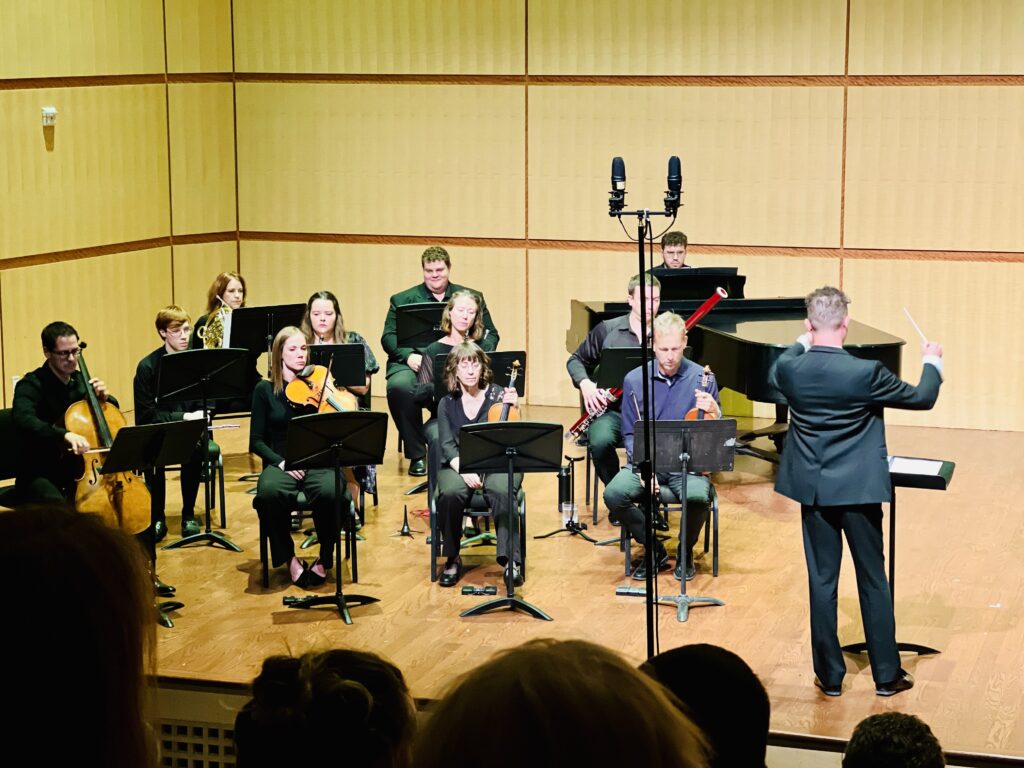
The opening selection was equally commanding in its execution: Dreams and Prayers of Isaac the Blind by Osvaldo Golijov (born 1960), scored for Klezmer clarinet and string quartet. The music, which echoes the aesthetics of Bela Bartók and George Enescu, was inspired by the story of Isaac the Blind, a celebrated rabbi from Provence known for his Cabbalistic underpinnings. The music in the piece, which the composer dedicated to his great-grandfather, has been described variously, respective to its five movements, as incorporating a “celestial accordion,” a cantor song, Klezmer dance and meditations. Clarinetist Erin Voellinger set the benchmark for this Utah premiere performance, joined by Lynn Rosen and Hasse Borup on violins; Erin Kipp on viola and Louis-Philippe Robillard on cello.
In the closing August concert, just as exceptional were the performances of several Brahms chamber music pieces featuring the clarinet: two Clarinet Sonatas, Op.120, one with Laura Grantier on clarinet and the other featuring Tad Calcara, along with pianist Vedrana Subotic who performed on both. Likewise, there was a smashingly good interpretation of the Trio for Clarinet, Cello, and Piano, Op.114, with Grantier, cellist Lauren Posey and Subotic.
Intermezzo returns to the courtyard gardens of The Grand America Hotel in downtown Salt Lake City in September with four blockbuster concerts, each one beginning at 7 p.m. This year’s series opens Sept. 7 with selections including music by Tchaikovsky and Schubert, featuring violinist William Hagen, cellist Pegsoon Whang and Subotic on piano. The Sept. 14 concert Music for the End of Time, includes commissions and arrangements of selections from the Radiohead catalogue by Christopher O’Riley, Lowell Liebermann, Igor Iachimciuc, and others — performed by pianist Sergei Kvitko. The Sept. 21 offering features tenor Brian Stucki and Subotic on piano, with the Schubert song cycle Die schöne Müllerin and the Broadway standard Some Enchanted Evening. The final concert Looking at Tomorrow on Sept. 27 will feature the Waterford Chamber Orchestra and soloists, conducted by Kathy Morris.
Tickets can be purchased here or at the door prior to each concert.
OUR CARNIVAL OF THE ANIMALS: THE PERFORMING ARTS COALITION AT THE ROSE
For the late summer in the last 14 years, the six residential companies in the Rose Wagner Center for Performing Arts have put on an open house of sorts to whet the community’s appetites for the forthcoming fall season. The average always has been high, but no question this year’s Our Carnival of the Animals was the best of the lot. And, the audience in the sold out Jeanné Wagner Theatre registered its roaring approval.
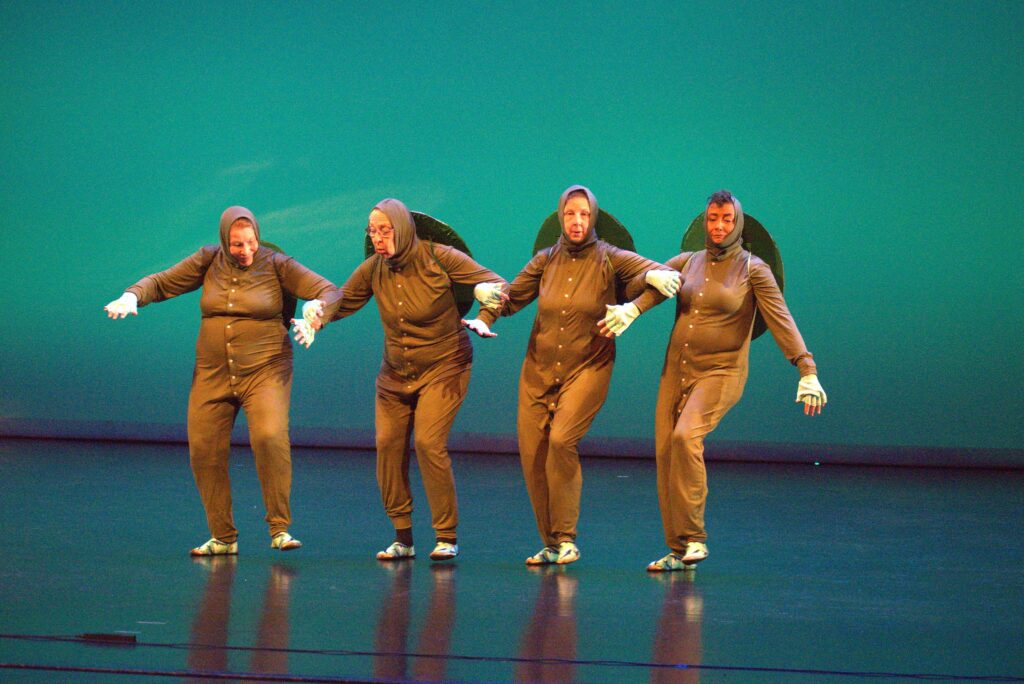
Joined by guest poets from Plumas Colectiva and pianists from Utah State University’s outstanding music school, Gina Bachauer International Piano Foundation, Plan-B Theatre, PYGmalion Theatre Company, Repertory Dance Theatre (RDT), Ririe-Woodbury Dance Company and SB Dance proved why each of their upcoming productions deserves a sold out house in the 2025-2026 season.
As noted in the preview, PYGmalion Theatre Company’s Fran Pruyn assembled the script for a “Carnival – A Zoological Fantasy” or “fantasmagorical arrangement,” which skillfully handled all of the moving parts that make any carnival an exhilarating sensory overload. One of Camille Saint-Saëns’ most familiar works, The Carnival of Animals, set the foundation for the production. At the center of it was the “Carnival of the Animals Management Team,” comprising four tortoises played by Barb Gandy, Tamara Howell, Joanne Rowland and Linda Smith.
As chief operating tortoise, Howell proclaimed, “Tortoises are more efficient, less verbose, and cost effective since we bring our own accommodations (gesturing to the shell on the back of one of her colleagues). Regarding their longevity, one line that drew especially hearty laughs from the crowd came from Smith, director emerita at RDT who recently retired after leading the dance company since its founding in 1966: “ I hoped to retire at 125.” IYKYK.
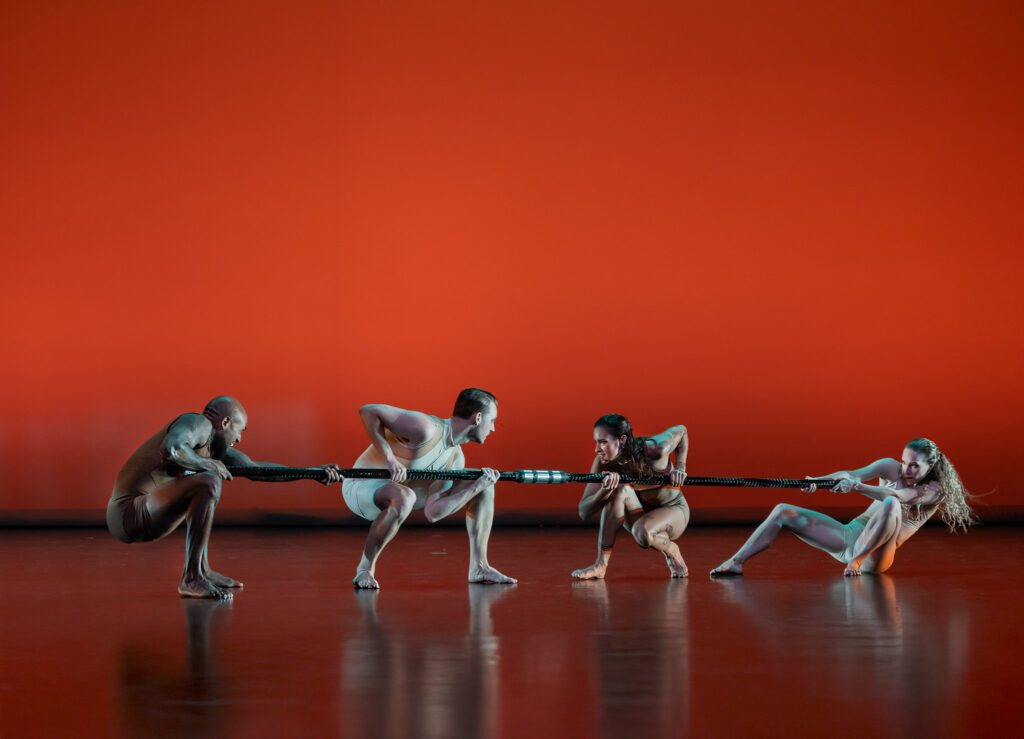
Invited by Plan-B Theatre, three poets from Plumas Colectiva — Melissa Salguero, Laura Ruiz and Monica Lisette — were impressive in demonstrating that even in carnival settings the true power of arts for nourishing our soul and conscience is just as evident and profound. Salguero’s stirring introduction as ringmaster was marvelous. To wit, this jewel of a stormwinder:
This is the Carnival!
Where lions strut in grass crowns of brass
Where swans, porcelain ghosts glide gracefully
Where snakes slither silent and sharp
Where tortoises tip-toe a tempo and teach us to take time in our hands, hold it like a lullaby
This is our Carnival
But not one of cages and chains
No. This is our cacophony crafted
a parade of masks, music, and refrains.
Where every beast you meet is you in disguise,
Stripped of the lies that we civilized.
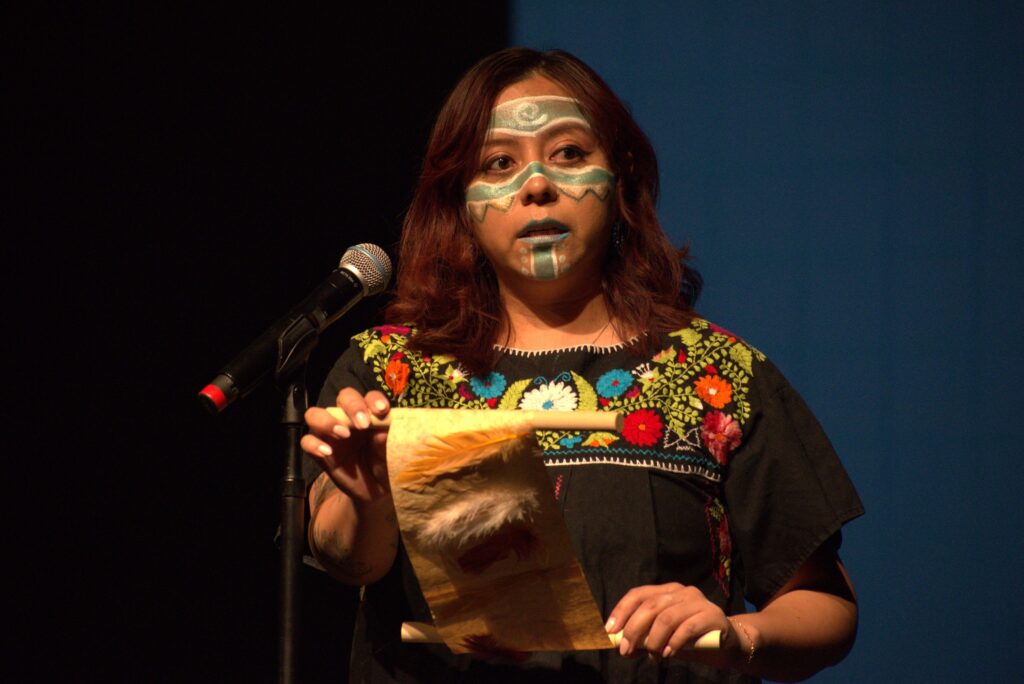
A bit later, Salguero championed the salaciousness of the venerable tortoises: “Wisdom ain’t a podium. It’s a shell. Etched with every scar we’ve walked through and named mine anyway.” In the Fossils section of the show, Ruiz, attired in the clothes celebrating her Nahuatl heritage, spoke in English and her native tongue about nourishing and watering the language and culture so that it otherwise will not dry and die out: We are nothing without the union/of our tongues, lands, and hands/We are all in collective resistance/in collective love/If we don’t fight for our fires to live/We will be but fossils at the end of the river/That once had hope but gave up.
Later, Lisette’s poem casts out the snakes, which acutely resonates with piercingly precise symbolism to elucidate the current tenor of our sociopolitical environments:
How quickly they try to blow you off when they think you’re just shiny coat and a colgate smile/ Forget that heart filled shells could never be hollow/That a pure white plumage only distracts from the red stained talons underneath/They only wanna see the pretty, polished, poised/Don’t wanna know about the gore it took to get us here/About how we’ve had to tame ourselves for their consumption?/They think they’re immune to the complicity, but they’re the reason we’re alllll here/And isn’t it ironic?
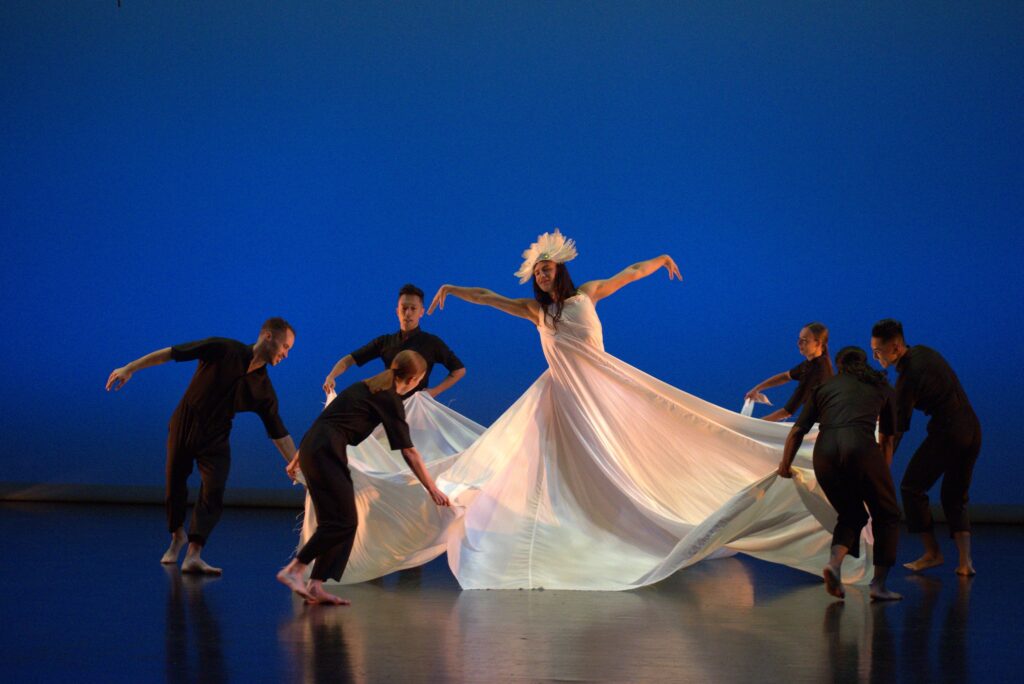
Photo: SB Dance.
Dancers from the three companies quickly won the hearts of the audience. Ririe-Woodbury dancers came in for the lions’ royal march, followed by RDT dancers in a hilarious bit as hens and roosters, followed by the first of several appearances of the quartet of hissing snakes (“we are just tourists looking for some fine dining”) performed by SB dancers. Other dance interludes, including some featuring RDT and Ririe-Woodbury dancers together, represented wild jackasses, elephants, kangaroos, aquarium fish, and cuckoos. And, there was the RDT performance of the swan, featuring a dancer in an outrageously oversized billowing gown, making for fine comedy that belied the famously elegant simplicity of the swan’s music in Saint-Saëns’ suite.
Finally, the musical performances were gobsmackingly sizzling. Representing USU’s premiere piano program, Cahill Smith and Shannon Hirschi offered a cavalcade of keyboard pyrotechnics on four-hand arrangements of the music by Saint-Saëns, along with Khachaturian’s Sabre Dance and an absolutely lovely performance of Rachmaninoff’s Vocalise, which brought a standing ovation. The biggest musical surprise came near the end, when Smith and Hirschi were joined by Aggie student pianists Adam Bowen and Chelsi Pulley (who added their own comedic touches) in a barn-burning eight-hands romp of Albert Lavignac’s Galop-Marche a huit mains.
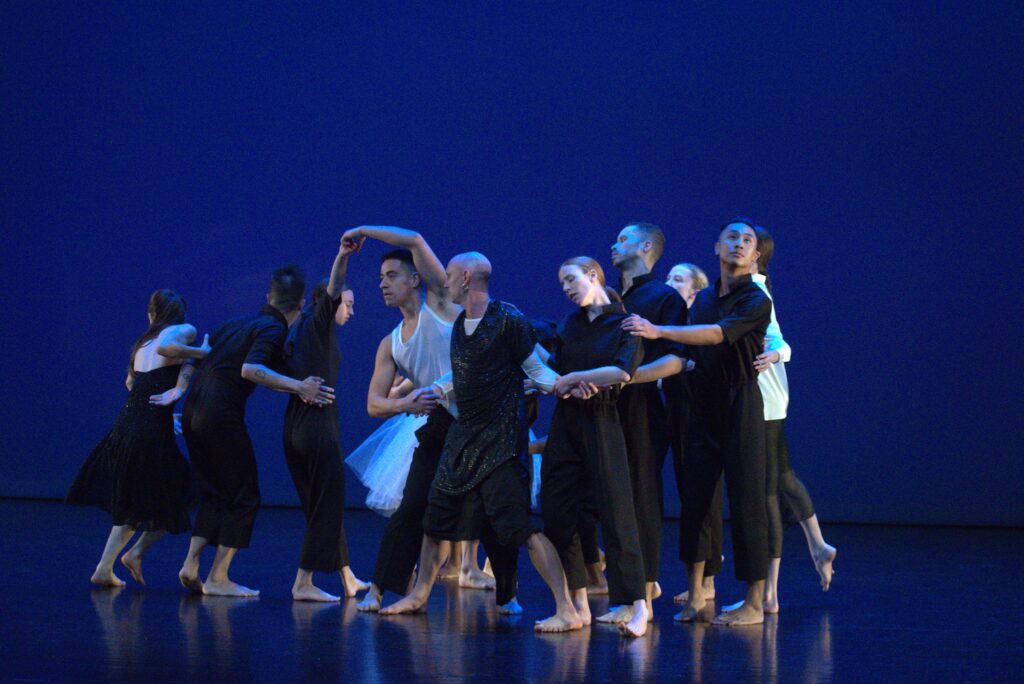
With just one rehearsal hours before the show to lock in all of the components that each company had perfected, the outcome was astonishingly tight, crisp and polished. This is why the bench is so deep in Utah’s performing arts scene.
Three of the resident companies have milestone anniversaries this upcoming season: RDT, 60th; Bachauer 50th and Plan-B, 35th. Ririe-Woodbury will open its 62nd season in September with Reverberation and a new artistic director, Leslie Kraus. PYGmalion Theatre Company has crafted a strong momentum in original and nationally known plays that celebrate women, including excellent plays by Utah playwrights. Launching into its new season, SB Dance is offering its latest edition of Curbside Theater, a traveling dance circus concert that can be seen in neighborhoods and public spaces in various Wasatch Front locations. SB Dance will have its annual rooftop show at the Pierpont Garage in downtown Salt Lake City on Sept. 3, beginning at 8:15 p.m.

